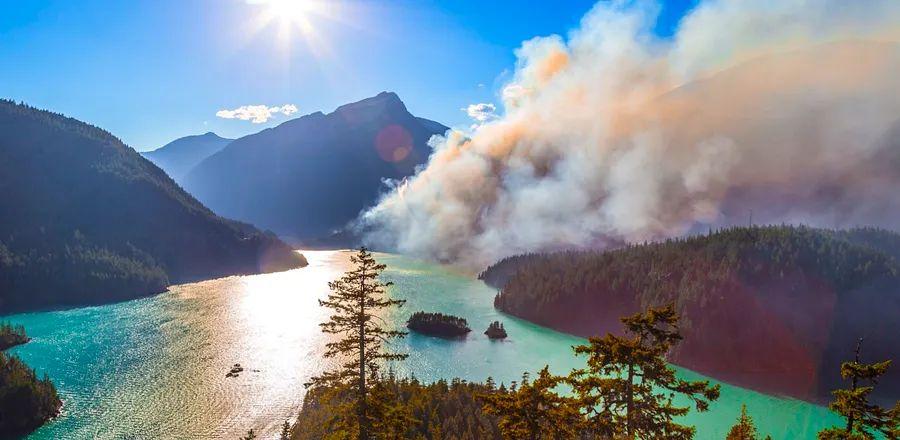Wildfires Endanger National Parks: Here’s How to Stay Safe Outdoors

Typically the busiest week of the year for Denali National Park and Preserve in Alaska, when thousands flock to hike, take scenic bus tours, meet the sled-dog rangers, and camp under the midnight sun, was disrupted by a wildfire that led to the park's closure. The unusual fire, which ignited on June 30, ravaged over 400 acres near the entrance in less than two weeks.
On July 10, the park reopened to the public, resuming normal activities except for one campground and trail still under wildfire monitoring. That same day, a brush fire erupted on Crater Road near Haleakalā National Park's entrance on Maui, the same island that faced devastation from the Lahaina wildfires in August 2023. The park is now closed indefinitely as crews battle the flames, although the county has stated that the rest of the island remains safe for travel.
This month, other national parks have also closed, not due to active wildfires but due to fire threats. Parts of Joshua Tree National Park turned away visitors over the Fourth of July weekend, citing extreme fire danger. More recently, Hawai’i Volcanoes National Park has shut down two roads near popular trailheads for the same concerns until further notice, and North Cascades National Park in Washington has closed several trails and campsites because of wildfire activity.
Here’s what you need to know about planning an outdoor vacation in areas prone to wildfires, along with tips on what to do if you encounter one.
When does wildfire season begin?
In much of the Western U.S., where many national parks are located, wildfire season typically begins in June and lasts through October, as stated by the National Wildfire Coordinating Group. This means the risk of additional wildfires is heightened this summer, particularly in areas where people enjoy recreational activities, including national parks, state parks, and other public outdoor spaces.
What causes wildfires?
The National Fire Protection Association explains that wildfires require three elements to ignite: fuel, air, and a heat source, a concept known as the fire triangle.
As of July 17, the U.S. has recorded 24,953 wildfires, according to the National Interagency Fire Center’s daily Incident Management Situation Report. This number is below the 10-year average of 31,061 fires for this period. However, the area burned so far in 2024 has reached 3,085,742 acres, surpassing the average of 2,931,422 acres for this time of year.
“Every year, we observe variations in the number of wildfires across the United States,” stated Tina Boehle, communication and education branch chief for the National Park Service Division of Fire and Aviation. “This fluctuation is influenced by ignition sources such as lightning, lava, and human activity. Without these ignitions, there are fewer wildfires.”
Boehle noted that her agency is witnessing an increase in wildfires occurring earlier and later in the year in certain regions. Instead of a defined fire season, we now experience a fire year—when fires can happen year-round, not just from June to October.
“A wildfire can ignite whenever conditions are favorable,” Boehle remarked.

Image courtesy of Garmin
Tips for Reducing Your Risk of Wildfire Encounters
“To minimize the chance of encountering wildfires, your best strategy is to consult with the land managers of the areas you plan to visit,” advised Zach Alexakis, a wildland firefighter and backcountry guide from Alaska who recently worked on a fire in Denali National Park. “National forests and parks maintain detailed maps of wildfires in the area and regularly update closures.”
If you're venturing into the backcountry, it’s crucial to plan ahead. Choose routes and campsites that are less susceptible to wildfires: steer clear of regions with thick, dry vegetation or those that have recently experienced drought. Additionally, check the weather forecast before heading out and be aware of sudden weather changes. Thunderstorms and elevated temperatures both heighten fire risk.
Boehle emphasized the importance of informing someone about your destination and having an emergency plan that includes multiple exit routes from your camping or hiking spot in case you need to evacuate quickly. It might also be beneficial to carry a satellite messenger or personal locator beacon, such as a Garmin inReach Messenger. These devices offer more reliable communication than a cellphone, which may lack service, and enable you to signal for assistance.
When planning a trip several months in advance, consider having a backup plan in case of wildfires. You can always explore another state park or national forest if your intended public lands are closed. Additionally, you can review the current fire-season outlook report (up to four months ahead), which provides insights into fire risk nationwide, helping you identify areas with lower hazards.
What should you do if you encounter smoke?
While spotting smoke can be concerning, it’s important to realize it might originate from a distant location. For instance, wildfires in Canada sent smoke across much of the United States last summer. Nevertheless, smoke is harmful to your health. According to AirNow, a government agency that tracks air quality, it's crucial to refrain from strenuous activities like running or intense hiking when conditions are smoky outside.
What steps should you take if you see flames?
If you observe a wildland fire, report its location to authorities (like a ranger) or call 911 right away. Provide as much detail as possible, including GPS coordinates, a mile marker, or the name of the nearby ridge, to help pinpoint the area. Even if someone else has reported the fire, your information can still assist emergency responders.
Alexakis advised that if you see flames, “move upwind of whatever is burning to stay out of its path,” and Boehle stressed that you should “never try to extinguish the fire on your own.”
Camping outdoors during wildfire season
For many, nighttime poses one of the greatest fears of camping during wildfire season. When you’re asleep, you may be less aware of your surroundings in the forest.
“Most populated areas have emergency systems that send alerts to phones in regions at risk of disasters,” Alexakis explained. “If you're in the backcountry without service, a ranger will inform you directly.”

Kevin Capretti/Shutterstock
How to avoid accidentally starting a wildfire
According to the National Park Service, nearly 85 percent of wildland fires in the United States are caused by human activity.
“Land managers implement burn bans when the forest is so dry that fires can easily ignite, so be aware of those restrictions before starting a campfire,” Alexakis advised.
If campfires are permitted, use a fire ring if one is available, keep the fire small, never leave it unattended, and make sure it’s completely extinguished before you leave. Additionally, have enough water on hand for emergencies and supervise young people closely.
Keep in mind that there are numerous ways to accidentally start a wildfire that don’t involve campfires, such as being careless with cigarettes or matches, using fireworks, or parking on dry grass (the hot undercarriage of a vehicle can ignite the vegetation).
Evaluation :
5/5



